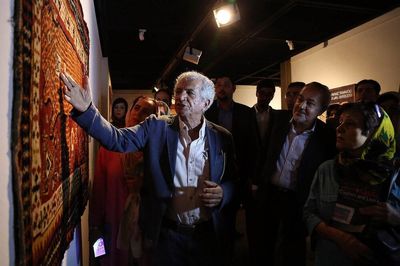The donation was made based on an agreement signed between Deputy Minister Mohammad-Hassan Talebian and the daughter of the Canada-based artist, Tandis, as his legal representative in Iran, the CHTHM announced on Tuesday.
The collection is composed of 408 rugs, kilims and carpets woven by Iranian nomads.
“My father has accumulated the collection from the villages and nomads across Iran over 60 years, and most of the rugs are not woven any longer and the nomads also do not exist any longer,” Tandis Tanavili said during the meeting with Talebian.
“Several books have been authored about this collection that my father believes belongs to Iran and should be preserved in the country,” she noted, and added that her father has always lamented the lack of a special section for Iranian rural and nomad carpets and rugs in Iranian museums.
She said that nine pieces from the collection will be put on display permanently at the Carpet Museum of Iran.
“The collection comprising rare invaluable nomad rugs, kilims and carpets will be showcased in a temporary exhibition at the Carpet Museum of Iran in the near future,” Talebian said during the meeting.
He added that a historical house in the southern Iranian city of Shiraz will be converted into a museum of Tanavoli’s artworks, which will also be a permanent place for displaying the donated collection.
A team of cultural heritage experts and the master’s family are scheduled to visit the house for a feasibility study next week.
Tanavoli has devoted himself to serious studies of Iranian nomad carpets and rugs, which have been published in the books “Shahsavan Iranian Rugs and Textiles” and “Persian Flatweaves”.
Tanavoli is also known for his expansive body of works including paintings, prints, ceramics, rugs and jewelry. In addition, the artist is a highly-regarded collector and poet.
In his latest book, “Mania for Collecting”, published this August, he tells about his passion for collecting strange and rare objects.
The Tehran City Council approved on Sunday to rename a street in the Niavaran neighborhood after Tanavoli.
Source: Tehran Times

